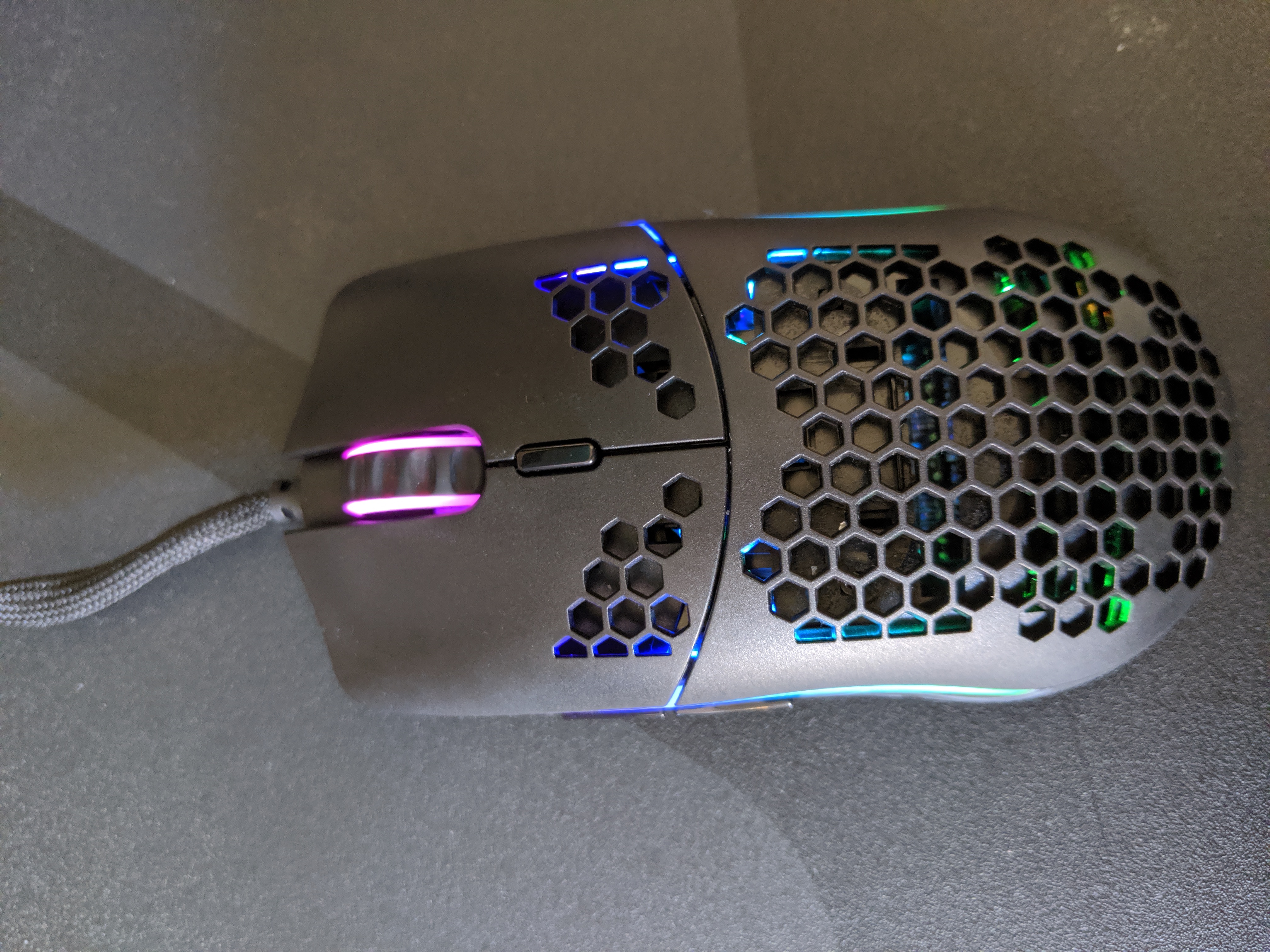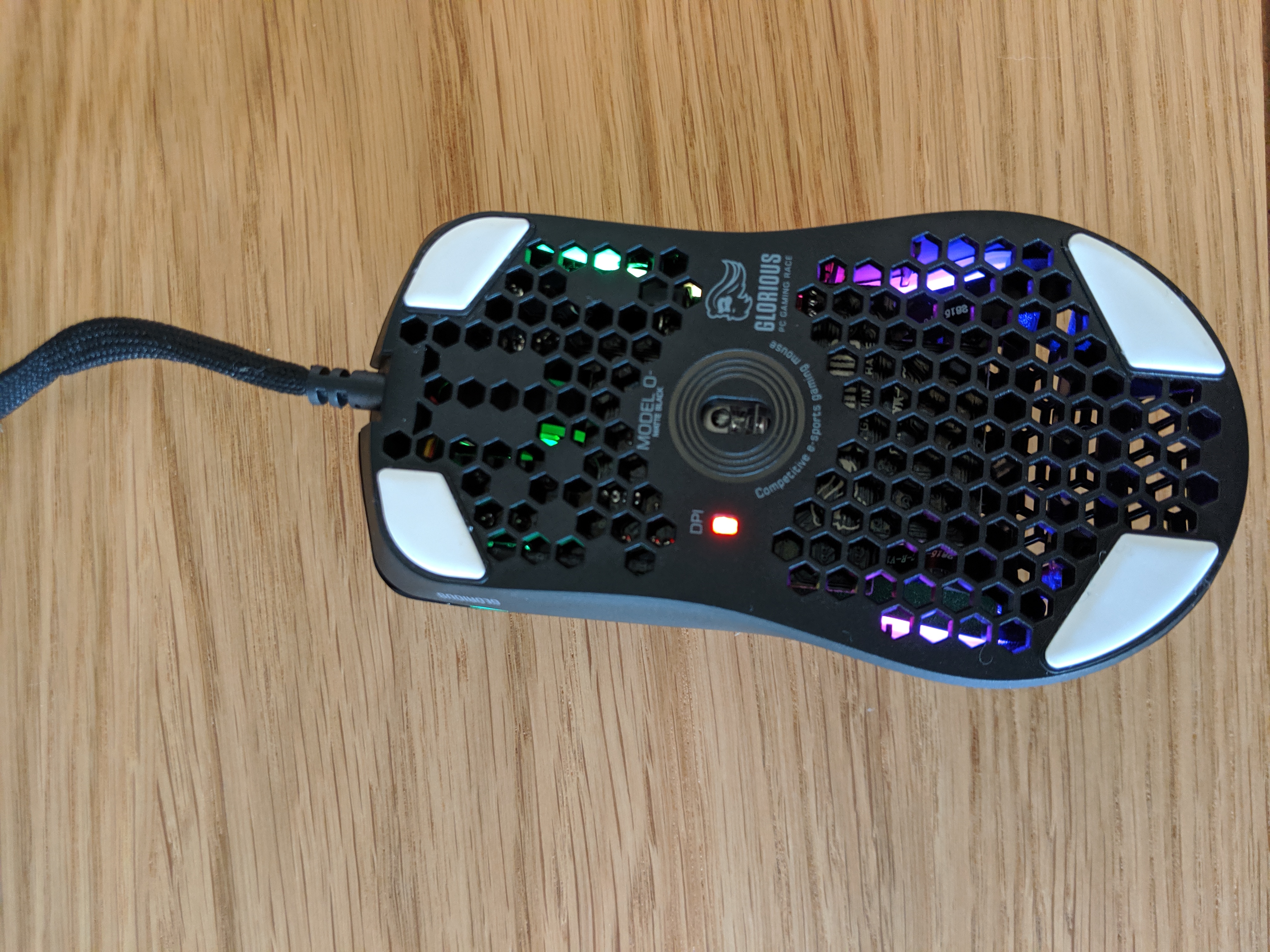Tom's Hardware Verdict
FPS enthusiasts will love how this feels in their hand. The Glorious Model O Minus is the complete package at a great price.
Pros
- +
Super lightweight
- +
Tried and tested sensor
- +
Great RGB implementation
- +
Extra large PTFE feet
Cons
- -
Looks and cable style may turn off some
- -
Ambidextrous design could be problematic
- -
No dedicated sniper button
Why you can trust Tom's Hardware
With branding referencing snooty PC gaming redditor memes, a striking perforated look and a crazy light 58g (0.13 pounds) weight, the Glorious Model O Minus is for a specific type of audience. This is a performance-focused gaming mouse for the type of player who visits 3Daimtrainer.com before every round of CS:GO Competitive, cracks a rye smile when they see the Pixart PMW-3360 sensor on the spec sheet and has genuinely considered fitting their mouse with aftermarket PTFE (a synthetic fluoropolyme for which the most common brand name is Teflon) feet. In short, it's a hardcore product for the hardcore seeking the best gaming mouse.
The price isn't anything as elitist as the subreddit which inspired the Glorious brand, though. It's available for $50/£45 from the Glorious website (cheaper than most BenQ Zowie models and well below Razer's RGB-equipped Elite series). And if you're not perturbed by its unusual appearance, there's a lot packed into the Model O Minus you'd ordinarily expect from pricier mice. In addition to that ubiquitous PMW-3360 optical sensor, there's a metric ton of RGB lighting in there, a unique ultra-flexible cable, Omron switches and optional software for tweaking the lighting and DPI modes.
Glorious Model O Minus (Matte) Specifications
| Sensor Type | Optical |
| Sensor Model | Pixart PMW-3360 |
| Sensitivity | 12,000 CPI |
| Polling Rates | 1,000 Hz |
| Lift-off Distance | 0.7mm (0.03 inches) |
| Programmable Buttons | 5 |
| LED Zones and Colors | 3 RGB zones |
| Cable Length | 6.5 feet (2m) |
| Measurements (LxWxH) | 4.72 x 2.28 x 1.42 inches (120 x 58 x 36mm) |
| Weight | 2.05 ounces (58g) |

Design and Comfort
This Model O Minus, as the name alludes to, is smaller than the regular Model O (same pricing, $49.99 for matte / $59.99 for glossy). The differences are minimal, but subtle differences in shape and size can make a big difference to a mouse's overall feel. The Minus measures 120mm long, 63mm wide and 36mm tall, while the regular version is 128 x 66 x 37.5mm. The Model O Minus also weighs less than the Model O. The Minus' matte (the version we're reviewing here) and glossy versions weigh 58g and 59g, respectively, as opposed to the Model O's respective 67g and 68g.
Palm grip gamers or those with great big dinner plates for hands will probably be more comfortable with the regular Model O, while those with more delicate digits and claw grip gamers who aim at the wrist, rather than with the forearms, will very likely find this immediately natural to control.
My personal preference for a gaming mouse's shape is that of the Microsoft Intellimouse or Zowie FK1. While the Minus felt smaller beneath my hand, it was just as comfortable to use as those other mice. Like many ambidextrous mice, the Minus ' control layout isn't perfectly symmetrical. It's two small browser navigation buttons are on the left side, which will be harder for lefties to reach. But besides that, there's isn't really anything getting in the way of comfortably enjoying the feel of the Model O Minus.
We did have initial reservations about the perforations in the body. It doesn't look like the most immediately comfortable mouse at face value, but then again neither did the original Mad Catz R.A.T. mouse with all its gaps and ridges, and that turned out to be a veritable massage table for gamer palms. If you're a particularly clammy-handed gamer, then cleaning will be an issue in the long-term. But even though this isn't exactly a wipe-clean mouse, the matte finish model we're testing doesn't show greasy marks or fingerprints.
The downside is the Model O Minus has a little bit of lateral movements on the left and right mouse buttons (this was also a complaint of online users of the larger Model O version). There's some give side-to-side if you're looking for it, but this is only noticeable during typical usage if you're holding down one of those buttons for a long time. At that point, holding the left or right mouse button (LMB or RMB) while moving the peripheral around with that extra give made the mouse feel fractionally less precise. That said, I never experienced accidental or missed LMB or RMB inputs during testing, so I don't consider it a significant problem.
Get Tom's Hardware's best news and in-depth reviews, straight to your inbox.
Gaming Performance
To put the the Model O Minus through its paces, I fired up 3Daimtrainer.com for a test-drive in flick-aiming and overall precision, followed by a few rounds of CS:GO. Having this new equipment at my command didn't suddenly make me as skilled as pro gamer S1mple, but the benefit of that super-lightweight design did make itself known, round by round.
Paired with a 144Hz gaming monitor the Model O Minus really did feel like eSports-grade equipment, tracking flick shot movements beautifully and giving a smooth response at a low DPI (dots per inch) setting. At the max 12,000 DPI setting, it was way beyond my usable range (but likely more fitting for highly skilled hardcore gamers), but the sensor was still smooth.

I'm splitting hairs here, but I wish the Model O Minus came with a dedicated low DPI/sniper button. I honed my sniping skills with a dab of blue sticky tack on my monitor screen many years ago, but if you're looking for a quick DPI adjust button, you'll be left wanting.
However, with the optional software (more on that later), it's possible to program your usual DPI and a lower sniping mode and use the button behind the mouse wheel to cycle between the two (who makes use of more than two DPI presets in the wild anyway?).
Donning our lab coats in order to embark on the super-scientific portion of our testing procedure, we load up MS Paint to draw some circles. You can learn a lot from those circles, and compared with the Alienware AW958 I use daily, I did see a slight difference in the regularity of the curves I was able to produce. Given that the two mice use the same sensor, I suspect this was due to the Model O Minus' super sprightly weight and large PTFE feet. The mouse feels exceptionally zippy on a hard hard mouse mat.
Features and Software
This humble reviewer has never really boarded the RGB hype train. Hopped on to get from A to B, maybe, but always hid in the toilets to dodge the ticket check. Multicolored flashing lights don't add value to a product for all gamers, but even I have to admit that the RGB lighting's implemented especially well on the Minus. It's all about the delicacy of the lighting zones.
The three lighting zones are only partially enabled by default. RGB zones within the body of the mouse itself are enabled using the Glorious Model O software, which takes up about 5MB of storage and presents all options on one simple page. You can really go to town on lighting schemes. I personally found it distracting to have all lighting zones active and madly cycling through colors, even with my hand over the mouse, so the default scheme's probably a happy middle ground.
Elsewhere on the app, you can set the DPI sensitivity steps and save profiles. The Glorious Model O software has everything you'd want a peripheral program to do without any unnecessary bells or whistles.
Bottom Line
Honestly, it's hard to find fault with this mouse. The build quality feels excellent, and although there is some slight lateral movement on the LMB and RMB, it never bothered me while gaming.

However, I do wish there was a button for easily switching DPI settings, especially for FPS games. But most of its downsides are totally subjective and cosmetic. The hole-filled design doesn't do much for me visually, but I love the ultra-lightweight feel. And that looser cable cover looks messy, but it's admittedly ultra-flexible.
If you're looking for a new FPS peripheral and play with either a claw grip or smaller hands, put this underneath your trigger finger and enjoy.
MORE: All Mice Content
MORE: All Gaming Content